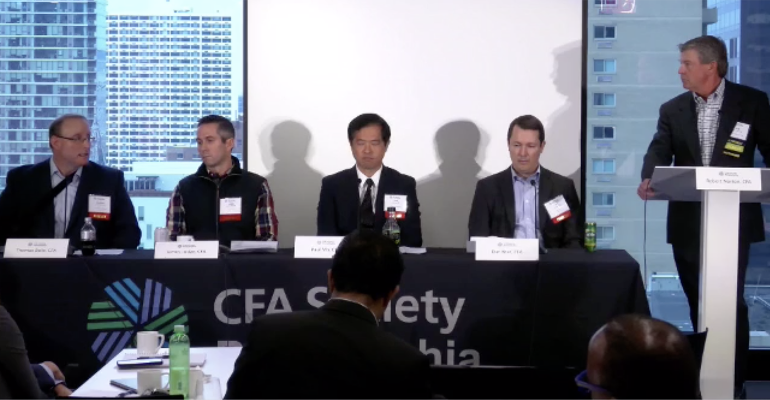While many argue that investment management has largely become commoditized in the wealth management world, a lot of advisors still hold themselves out as investment managers. But advisors are going to have to free up some capacity to accelerate their growth, and introducing some standardization into the investment process can help them do so, according to panelists at CFA Society Philadelphia’s Annual Private Wealth Management Conference.
Paul Ma, a vice president and lead portfolio strategist at Fidelity Investments, said his team has analyzed some 20,000 advisor portfolios, finding that advisors are stretching themselves thin customizing investments for clients.
“One of the most common things we see is that advisors have 100 clients with 100 different portfolios with about 300 different investments or security tickers,” Ma said. “You got to ask yourself the question, how many investments can you keep track of as a fiduciary?”
Ma recommended advisors have one core portfolio for clients that they can tweak a little here and there, but this limits the number of securities they have to keep track of.
James Judge, portfolio manager at Almanack Investment Partners, said advisors should keep it to nine to 12 model portfolios.
“At the end of the day, do advisors actually want to have a customized portfolio for every client?” Judge asked. “No, it’s the client that wants that experience. The key is standardized customization. Come up with a process, come up with a methodology where the client feels it’s customized, but at the end of the day, it’s very systematic and structured in the background.”
Judge said he has talked to a lot of advisors who have reached a sort of growth plateau.
“They want to get from where they’re at now to double within three years, and the key to that is you have to free up capacity,” he said.
Judge said technology is a key factor to providing a customized portfolio management experience that’s also scalable.
“We highly leverage technology to deliver what a client feels like is a customized experience despite the fact it’s standardized behind the scenes,” he said.
Thomas Balis, chief investment officer, Cornerstone Portfolio Research, said the technology used by RIAs across the industry is very diverse. His RIA clients use multiple custodians, as well as portfolio management platforms like Tamarac, Black Diamond and Orion; they use Junxure or Advyzon for CRM, and rebalancing through Tamarac, Black Diamond and iRebal.
“What we’ve found is that it’s so dramatically underleveraged,” Balis said.
His firm tends to work with RIAs with from $100 to $400 million in assets, and don’t have the time to develop the operational expertise in using these applications.
But Balis said technology has gotten good enough to allow advisors to have a standardized investment structure that will work around long-held legacy positions.
“The advisors have built a business for 10 or 20 years, and they have really strongly held beliefs about really core investments, and they don’t want to rip the Band-Aid off. They’ve been, for lack of a better term, selling this value proposition for decades, and so they don’t want to turn around to their clients and say, ‘Well I know I told you that this way was good for the last 10 years, but now we’re going to sell all of that and do something over here.’ They want to be able to do both. They want to have the standardization but also be able to work around legacy positions that are important to the client, that are important to the advisor.”
Whether an advisor decides to use centralized portfolios or not, what matters more is having confidence in the approach, said Dan Braz, head of the intermediary ETF strategist team at State Street Global Advisors. He said advisors might be surprised how receptive clients are to model portfolios.
“If you think that maybe they wouldn’t be comfortable with a scalable model portfolio, it may be worth trying it with one or two clients, because you might find that if you really believe in it, they will as well.”





